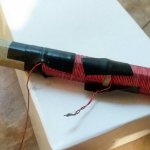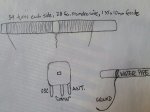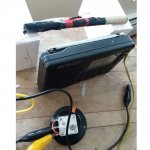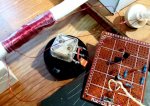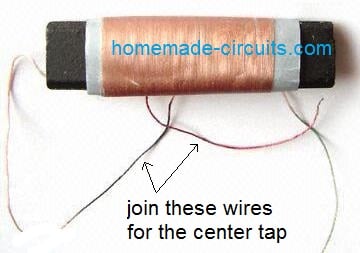majoco
Stirrer
Right, let's stop all the guesswork and duff advice - the proof of the theory in one try!
First pic - only a short ferrite rod, a turn of cardboard held in place with masking tape. 50 turns of thin insulated copper wire and a tuning capacitor marked '435pf' from the junk box. 50 turns corresponds well with that chart on my previous post.
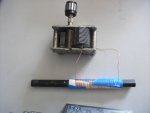
Second pic - the radio is not connected to the ferrite rod.
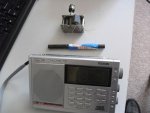
Third pic - tuned into a very faint sports programme on 1035kHz, doen't even bring up one division on the signal meter - those lines on the top left of the screen.
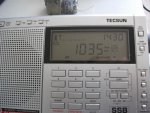
Fourth pic - tuned the capacitor by ear for the strongest signal on the meter - now three bars and good clear signal of some footy match. The tuning is very sharp.
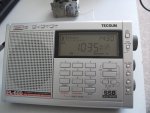
Tuned up and down the band at each end and a good result all over. I'd say that this rough experiment was a success. No ground or coupling coil involved - the "Q" of the external antenna was so high that it boosts the signal picked up by the ferrite antenna in the radio. Now with a longer rod and tuned at the low frequency end of the band you should have even better results. Have fun!
First pic - only a short ferrite rod, a turn of cardboard held in place with masking tape. 50 turns of thin insulated copper wire and a tuning capacitor marked '435pf' from the junk box. 50 turns corresponds well with that chart on my previous post.

Second pic - the radio is not connected to the ferrite rod.

Third pic - tuned into a very faint sports programme on 1035kHz, doen't even bring up one division on the signal meter - those lines on the top left of the screen.

Fourth pic - tuned the capacitor by ear for the strongest signal on the meter - now three bars and good clear signal of some footy match. The tuning is very sharp.

Tuned up and down the band at each end and a good result all over. I'd say that this rough experiment was a success. No ground or coupling coil involved - the "Q" of the external antenna was so high that it boosts the signal picked up by the ferrite antenna in the radio. Now with a longer rod and tuned at the low frequency end of the band you should have even better results. Have fun!
Last edited:


